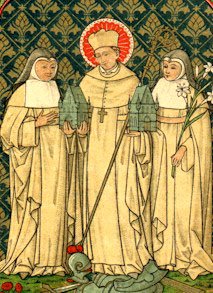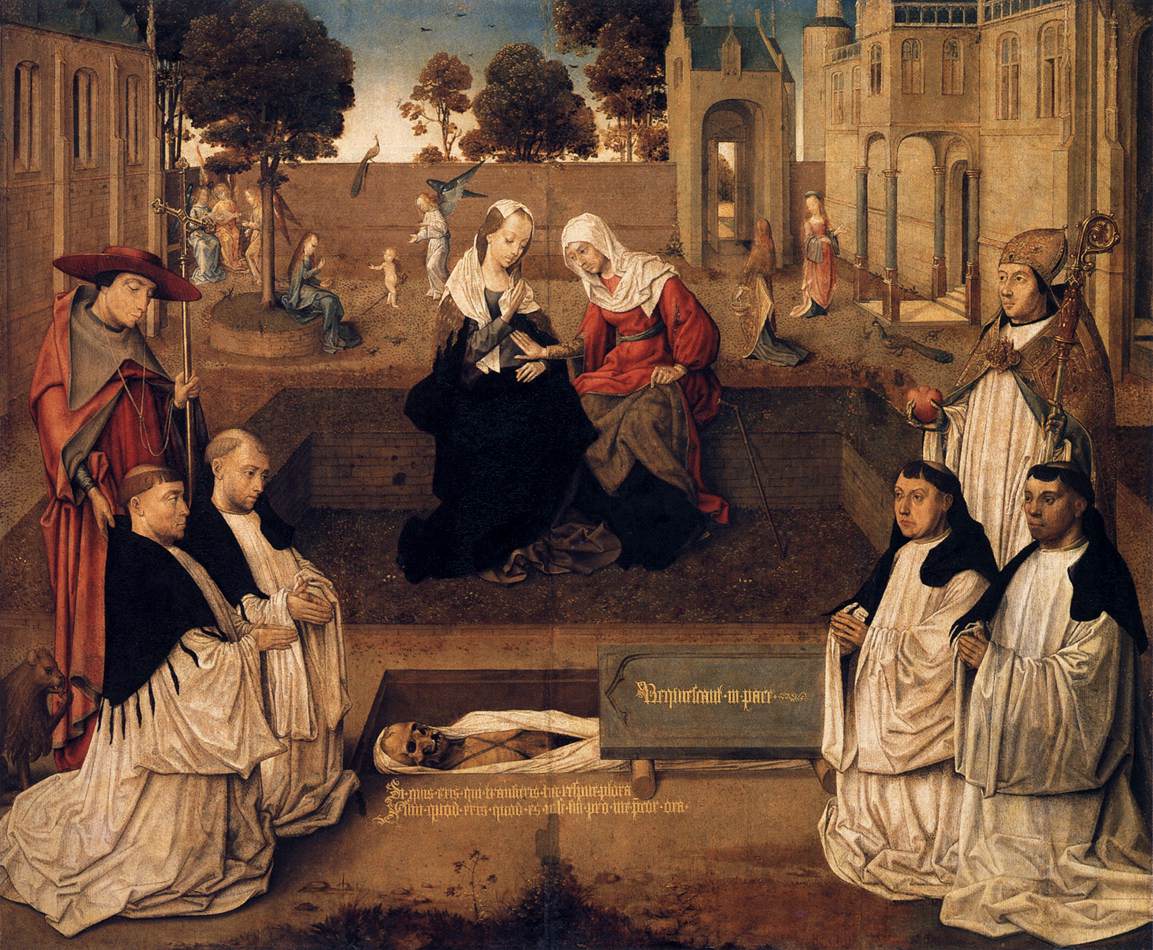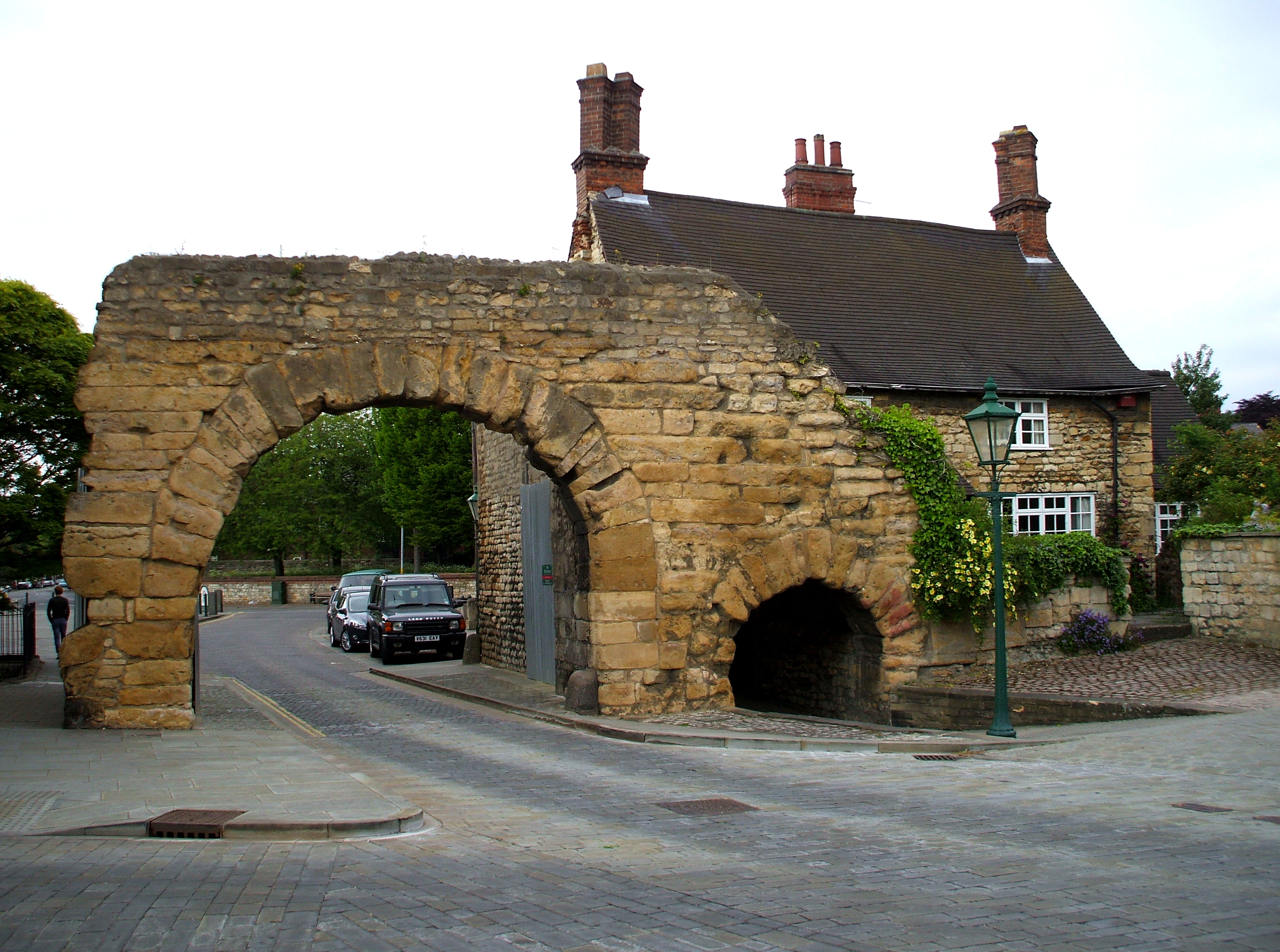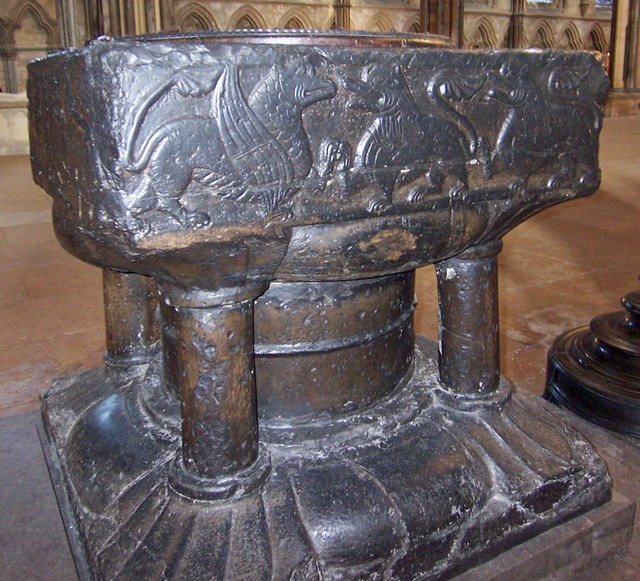|
St Katherine's Priory, Lincoln
St Katherine's Priory also known as The Priory of Saint Katherine without Lincoln was a Gilbertine priory of Canons Regular on the Fosse Way just outside the walls of Lincoln, England. The priory ran the Hospital of St Sepulchre, probably the first hospital in the city. History The community which followed the Rule of Saint Augustine was founded not long after the approval of St Gilbert's order in 1148 when Robert de Chesney invited them to minister in the city. The priory and church came with the Hospital of Saint Sepulchre which had been established by Bishop of Lincoln Robert Bloet sometime between 1093 and 1123. The community was chiefly male, made up of around 16 Canons, but there is evidence of a number of female lay sisters living alongside to help with medical care in the hospital. The community was under the patronage of Saint Catherine of Alexandria, a fourth century Egyptian missionary, philosopher and martyr, the patron saint of learning and the dying. The key ... [...More Info...] [...Related Items...] OR: [Wikipedia] [Google] [Baidu] |
Gilbertine
The Gilbertine Order of Canons Regular was founded around 1130 by Saint Gilbert in Sempringham, Lincolnshire, where Gilbert was the parish priest. It was the only completely English religious order and came to an end in the 16th century at the time of the Dissolution of the Monasteries. Modest Gilbertine revivals have taken place in the late 20th and early 21st centuries on three continents. Founding Gilbert initially established a community for enclosed contemplative nuns. He accepted seven women whom he had taught in the village school and in 1131 founded an order of nuns based on the Cistercian Rule. Gilbert set up buildings and a cloister for them against the north wall of the church, which stood on his land at Sempringham, and gave them a rule of life, enjoining upon them chastity, humility, obedience, and charity. Their daily necessaries were passed to them through a window by some girls chosen by Gilbert from among his people. As the serving maids requested that the ... [...More Info...] [...Related Items...] OR: [Wikipedia] [Google] [Baidu] |
North Hykeham
North Hykeham is an industrial town and civil parish in the North Kesteven, North Kesteven District of Lincolnshire, England. It is located directly south of the city of Lincoln, England, Lincoln, where it forms the southern part of the wider Lincoln Urban Area along with Waddington, Lincolnshire, Waddington, Bracebridge Heath, Canwick and South Hykeham. The parish covering the town had a population of 16,844 in the 2021 Census. History North Hykeham was originally spelt "North Hyckham", and is commonly referred to as just 'Hykeham'. North Hykeham is independent from Lincoln, despite being contiguous with the city and its surrounding areas. The old village dates back to the Angles, Germanic invaders who occupied much of Britain after the Romans left circa 400 AD. The Danes and Vikings arrived in Lincolnshire circa 900 AD, hence places with names ending in –by, thorpe and ham (which mean ‘village’). The Domesday Book (1086) records that North Hykeham had 15 households and ... [...More Info...] [...Related Items...] OR: [Wikipedia] [Google] [Baidu] |
Robert Bloet
Robert Bloet (sometimes Robert Bloett;Knowles ''Monastic Order'' p. 132 died 1123) was Bishop of Lincoln 1093–1123 and Chancellor of England. Born into a noble Norman family, he became a royal clerk under King William I. Under William I's son and successor King William II, Bloet was first named chancellor then appointed to the See of Lincoln. Continuing to serve the king while bishop, Bloet remained a close royal councillor to William II's successor, King Henry I. He did much to embellish Lincoln Cathedral, and gave generously to his cathedral and other religious houses. He educated a number of noblemen, including illegitimate children of Henry I. He also was the patron of the medieval chronicler Henry of Huntingdon, and was an early patron of Gilbert of Sempringham, the founder of the Gilbertine monastic order. Early life Bloet was a member of the Norman noble family that held Ivry in Normandy. Bloet was related in some manner to Hugh, the Bishop of Bayeux from 1015 to 10 ... [...More Info...] [...Related Items...] OR: [Wikipedia] [Google] [Baidu] |
Church Of The Holy Sepulchre
The Church of the Holy Sepulchre, also known as the Church of the Resurrection, is a fourth-century church in the Christian Quarter of the Old City of Jerusalem, Old City of Jerusalem. The church is the seat of the Greek Orthodox Patriarchate of Jerusalem. Some consider it the holiest site in Christianity and it has been an important pilgrimage site for Christians since the Christianity in the 4th century, fourth century. According to traditions dating to the fourth century, the church contains both the site where Jesus was Crucifixion of Jesus, crucified at Calvary, or Golgotha, and the location of Jesus's empty Tomb of Jesus, tomb, where he was Burial of Jesus, buried and, according to Christian belief, Resurrection of Jesus, resurrected. Both locations are considered immensely holy sites by some Christians. The church and rotunda was built under Constantine the Great, Constantine in the 4th century and destroyed by Al-Hakim bi-Amr Allah, al-Hakim in 1009. Al-Hakim's son al ... [...More Info...] [...Related Items...] OR: [Wikipedia] [Google] [Baidu] |
Gilbert Of Sempringham
Gilbert of Sempringham (c. 1085 – 4 February 1189) was an English Catholic who founded the Gilbertine Order. He was the only medieval Englishman to found a conventual order, mainly because the Cîteaux Abbey declined his request to assist him in organising a group of nuns living with lay brothers and sisters. He founded a double monastery of canons regular and nuns in spite of such a foundation being contrary to canonical practice. Life Gilbert was born at Sempringham, near Bourne in Lincolnshire, the son of Jocelin, an Anglo-Norman lord of the manor, and an unnamed Anglo-Saxon mother. He had a brother, Roger, and a sister, Agnes. Unusually for that period, his father actively prevented his son from becoming a knight, instead sending him to France, probably the University of Paris but possibly under Anselm of Laon, to study theology. Some physical deformity may have made him unfit for military service, making an ecclesiastical career the best option. When he returned in 1 ... [...More Info...] [...Related Items...] OR: [Wikipedia] [Google] [Baidu] |
Rule Of Saint Augustine
The Rule of Saint Augustine, written in about the year 400, is a brief document divided into eight chapters and serves as an outline for religious life lived in community. It is the oldest monastic rule in the Western Church. The rule, developed by Augustine of Hippo (354–430), governs chastity, poverty, obedience, detachment from the world, the apportionment of labour, the inferiors, fraternal charity, prayer in common, fasting and abstinence proportionate to the strength of the individual, care of the sick, silence and reading during meals. It came into use on a wide scale from the twelfth century onwards and continues to be employed today by many orders, including the Dominicans, Servites, Mercederians, Norbertines, and Augustinians. Monastic life of Saint Augustine In 388, Augustine returned from Milan to his home in Thagaste. He then sold his patrimony and gave the money to the poor. The only thing he kept was the estate, which he converted into a monastic foundatio ... [...More Info...] [...Related Items...] OR: [Wikipedia] [Google] [Baidu] |
Fosse Way
The Fosse Way was a Roman road built in Britain during the first and second centuries AD that linked Isca Dumnoniorum (Exeter) in the southwest and Lindum Colonia ( Lincoln) to the northeast, via Lindinis ( Ilchester), Aquae Sulis ( Bath), Corinium (Cirencester), and Ratae Corieltauvorum (Leicester). Toponym The word Fosse is derived from the Latin , meaning 'ditch'. For the first few decades after the Roman invasion of Britain in 43 AD, the Fosse Way marked the western frontier of Roman rule in Iron Age Britain. It is possible that the road began as a defensive ditch that was later filled in and converted into a road, or possibly a defensive ditch ran alongside the road for at least some of its length. Route The road joined Akeman Street and Ermin Way at Cirencester, crossed Watling Street at ''Venonis'' ( High Cross) south of Leicester, and joined Ermine Street at Lincoln. The Antonine Itinerary (a 2nd-century Roman register of roads) includes the section ... [...More Info...] [...Related Items...] OR: [Wikipedia] [Google] [Baidu] |
Canons Regular
The Canons Regular of St. Augustine are Catholic priests who live in community under a rule ( and κανών, ''kanon'', in Greek) and are generally organised into Religious order (Catholic), religious orders, differing from both Secular clergy, secular canons and other forms of religious life, such as clerics regular, designated by a partly similar terminology. As religious communities, they have laybrothers as part of the community. At times, their Orders have been very popular: in England in the 12th century, there were more houses of canons (often referred to as an abbey or canonry) than monasteries of monks. Preliminary distinctions All canons regular are to be distinguished from canon (priest), secular canons who belong to a resident group of priests but who do not take religious vows, public vows and are not governed in whatever elements of life they lead in common by a historical rule. One obvious place where such groups of priests are required is at a cathedral, where ... [...More Info...] [...Related Items...] OR: [Wikipedia] [Google] [Baidu] |
St Catherine's, Lincoln
St Catherine's is an inner-city area of Lincoln, Lincolnshire, Lincoln in Lincolnshire, England at the southern end of the High Street, Lincoln, High Street, and centred on a roundabout at its junction with the A15 road (England), A15, B1190 (Newark Road) and South Park Avenue (continuation of the A15). The area is bordered by South Common in the east and the River River Witham, Witham in the west. It is built over the site of the 12th century Priory of St Katherine's Priory, Lincoln, Saint Katherine without Lincoln, a monastic community that ran the Hospital of Saint Sepulchre. St Katherine's The area is named after the dominant St Katherine's Church, Lincoln, church of St Katherine, a Grade II listed, landmark building and Anglican church.www.lincolnpriory.org St Katherine's has views over the South Comm ... [...More Info...] [...Related Items...] OR: [Wikipedia] [Google] [Baidu] |
Lincoln, England
Lincoln () is a cathedral city and non-metropolitan district, district in Lincolnshire, England, of which it is the county town. In the 2021 Census, the city's district had a population of 103,813. The 2021 census gave the Lincoln Urban Area, urban area of Lincoln, including Bracebridge Heath, North Hykeham, South Hykeham and Waddington, Lincolnshire, Waddington, a recorded population of 127,540. Roman Britain, Roman ''Lindum Colonia'' developed from an Iron Age settlement of Celtic Britons, Britons on the River Witham, near the Fosse Way road. Over time its name was shortened to Lincoln, after successive settlements, including by Anglo-Saxons and Danes (tribe), Danes. Landmarks include Lincoln Cathedral (English Gothic architecture; for over 200 years the world's tallest building) and the 11th-century Norman architecture, Norman Lincoln Castle. The city hosts the University of Lincoln, Bishop Grosseteste University, Lincoln City F.C. and Lincoln United F.C. Lincoln is the large ... [...More Info...] [...Related Items...] OR: [Wikipedia] [Google] [Baidu] |
Robert De Chesney
Robert de Chesney (died December 1166) was a medieval English Bishop of Lincoln. He was the brother of an important royal official, William de Chesney, and the uncle of Gilbert Foliot, successively Bishop of Hereford and Bishop of London. Educated at Oxford or Paris, Chesney was Archdeacon of Leicester before his election as bishop in December 1148. Chesney served as a royal justice in Lincolnshire during his bishopric, and maintained a close relationship with his nephew, Foliot. He was also an early patron of Thomas Becket, and gave the young cleric an office in his diocese early in Becket's career. Although shown favour by Stephen of England, King Stephen, including the right to a Mint (facility), mint, Chesney was present at the coronation of Henry II of England, King Henry II in 1154 and went on to serve Henry as a royal justice. Around 1160, Chesney became embroiled in a dispute with St Albans Abbey in the diocese of Lincoln, over his right as bishop to supervise the abbey. T ... [...More Info...] [...Related Items...] OR: [Wikipedia] [Google] [Baidu] |
Saint Gilbert Of Sempringham
Gilbert of Sempringham (c. 1085 – 4 February 1189) was an English Catholic who founded the Gilbertine Order. He was the only medieval Englishman to found a conventual order, mainly because the Cîteaux Abbey declined his request to assist him in organising a group of nuns living with lay brothers and sisters. He founded a double monastery of canons regular and nuns in spite of such a foundation being contrary to canonical practice. Life Gilbert was born at Sempringham, near Bourne in Lincolnshire, the son of Jocelin, an Anglo-Norman lord of the manor, and an unnamed Anglo-Saxon mother. He had a brother, Roger, and a sister, Agnes. Unusually for that period, his father actively prevented his son from becoming a knight, instead sending him to France, probably the University of Paris but possibly under Anselm of Laon, to study theology. Some physical deformity may have made him unfit for military service, making an ecclesiastical career the best option. When he returned in 112 ... [...More Info...] [...Related Items...] OR: [Wikipedia] [Google] [Baidu] |






